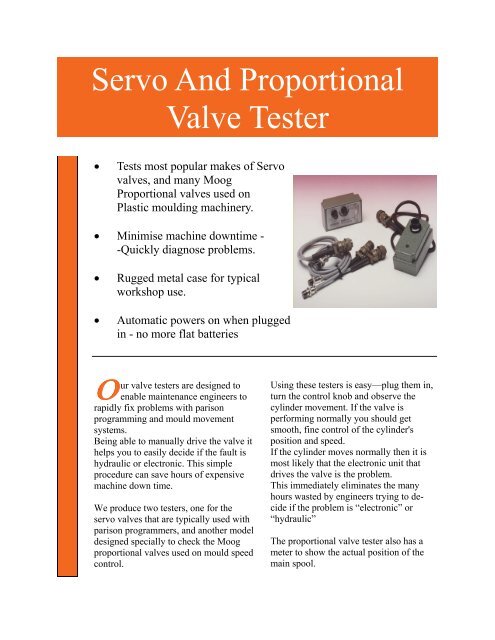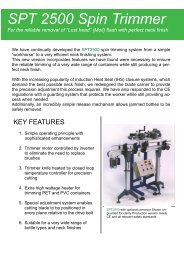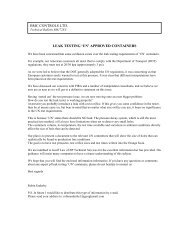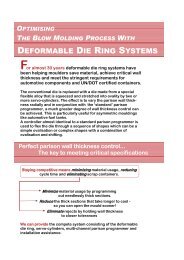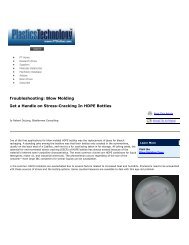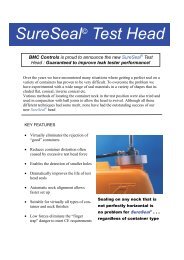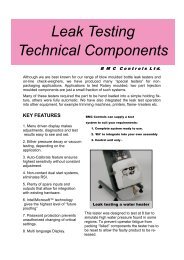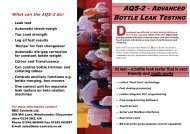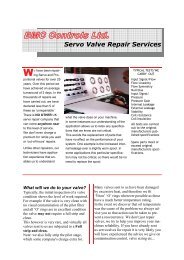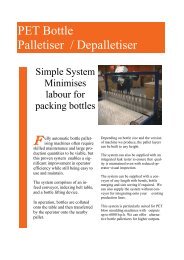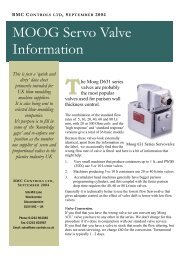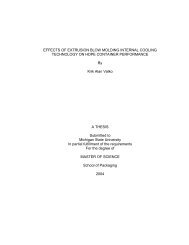Servo test boxes - Blow Moulding Controls
Servo test boxes - Blow Moulding Controls
Servo test boxes - Blow Moulding Controls
Create successful ePaper yourself
Turn your PDF publications into a flip-book with our unique Google optimized e-Paper software.
<strong>Servo</strong> And Proportional<br />
Valve Tester<br />
• Tests most popular makes of <strong>Servo</strong><br />
valves, and many Moog<br />
Proportional valves used on<br />
Plastic moulding machinery.<br />
• Minimise machine downtime -<br />
-Quickly diagnose problems.<br />
• Rugged metal case for typical<br />
workshop use.<br />
• Automatic powers on when plugged<br />
in - no more flat batteries<br />
O<br />
ur valve <strong>test</strong>ers are designed to<br />
enable maintenance engineers to<br />
rapidly fix problems with parison<br />
programming and mould movement<br />
systems.<br />
Being able to manually drive the valve it<br />
helps you to easily decide if the fault is<br />
hydraulic or electronic. This simple<br />
procedure can save hours of expensive<br />
machine down time.<br />
We produce two <strong>test</strong>ers, one for the<br />
servo valves that are typically used with<br />
parison programmers, and another model<br />
designed specially to check the Moog<br />
proportional valves used on mould speed<br />
control.<br />
Using these <strong>test</strong>ers is easy—plug them in,<br />
turn the control knob and observe the<br />
cylinder movement. If the valve is<br />
performing normally you should get<br />
smooth, fine control of the cylinder's<br />
position and speed.<br />
If the cylinder moves normally then it is<br />
most likely that the electronic unit that<br />
drives the valve is the problem.<br />
This immediately eliminates the many<br />
hours wasted by engineers trying to decide<br />
if the problem is “electronic” or<br />
“hydraulic”<br />
The proportional valve <strong>test</strong>er also has a<br />
meter to show the actual position of the<br />
main spool.
M<br />
oog servo valves<br />
— for precise<br />
repeatable control. Once<br />
upon a time servo valves<br />
were very expensive and<br />
very dirt sensitive. This all<br />
changed when Moog introduced<br />
the “631” series. Using<br />
new production techniques<br />
Moog were able to reduce the<br />
cost, and larger nozzles and<br />
orifices reduced dirt sensitivity.<br />
Moog are still at the forefront<br />
of machine control by being<br />
the largest supplier of high<br />
performance electrical servo<br />
drives for the new “all electric”<br />
blow moulding machines.<br />
The<br />
Moog<br />
“631” series are available<br />
in 6 flow rates from 5lt/<br />
min up to 80lt/min<br />
This makes it ideal for<br />
the smallest to the largest<br />
blow moulding machines.<br />
BMC always have a good<br />
stock of new and refurbished<br />
valve available for<br />
same day dispatch<br />
MOOG PROPORTIONAL VALVES<br />
M<br />
any new machines<br />
have<br />
Moog propor- tional<br />
valves for controlling mould,<br />
carriage, push-out, and<br />
blow pin movements<br />
Our BM-xxx <strong>test</strong>er is presently<br />
suitable for most Moog<br />
valves that are fitted with 5, 6<br />
and 12 pin connectors.<br />
Please give us the model<br />
numbers of your valves<br />
you have to enable us to<br />
check the suitability of our <strong>test</strong>er.<br />
WHY DO SERVO<br />
VALVES GO WRONG?<br />
In blow moulding, the commonest<br />
cause of servo valve failure is HEAT.<br />
Either the hydraulic cooling water was<br />
shut off, or the valve sat “cooking” on<br />
the head with the “heats” on, and the<br />
hydraulic supply turned off.<br />
The oil inside the valve turns to a<br />
thick gummy mess, and the valve cannot<br />
operate. Additionally the heat<br />
turns the “O” rings brittle and the<br />
valve will then leak. Hydraulic filtration<br />
is also important and we recommend<br />
that the pressure line filter element<br />
is changed at least once a year.<br />
Always ‘cap off’ hose ends and open<br />
ports when performing head changes.<br />
WHY DO PROPORTIONAL<br />
VALVES GO WRONG?<br />
Most machines have a separate filter in the<br />
pressure supply to the pilot stage of the proportional<br />
valve.<br />
It is very important that the filter element is<br />
changed whenever the dirt indicator switch is<br />
energised. This is particularly true with older<br />
valves that were of a more dirt sensitive design.<br />
Unlike servo valves which are virtually always<br />
have a ‘closed centre’ ‘zero dead-band’ characteristic,<br />
there are numerous different types of<br />
proportional valves.<br />
BMC <strong>Controls</strong> Ltd<br />
Silk Mill Lane. Winchcombe, Glos. GL545HZ<br />
Phone 01242 604040 Fax 01242 603987 E-Mail sales@bmc-controls.co.uk


